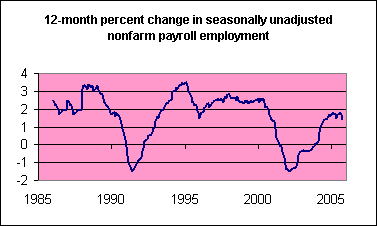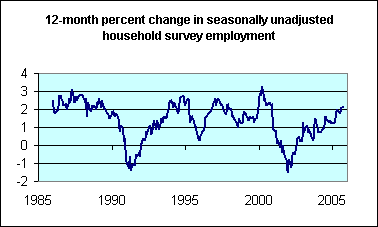Last week’s GDP statistics and this week’s productivity data gave us something to cheer about. Friday’s employment figures do not.
The Bureau of Labor Statistics reported Friday that U.S. employment increased by only 56,000 jobs in October, about a third of the number needed to keep up with the growing population, according to seasonally adjusted data based on the establishment survey of nonfarm payrolls. Employment actually fell in September.
Kash at Angry Bear is troubled that recent employment gains have predominantly come from construction. If Calculated Risk is correct that the housing boom is about to go bust, that dependence on construction could be a source of concern.
Macroblog notes that there can be significant month-to-month noise in these statistics, and seasonal adjustment is also quite important. Without seasonal adjustment, the establishment survey actually shows 702,000 rather than 56,000 net new jobs created in October. But because October is usually very strong (averaging 716,000 net new jobs before seasonal adjustment in each of the previous 10 Octobers), the 702,000 seasonally unadjusted job growth gets expressed as 56,000 seasonally adjusted new jobs.

One way to smooth out the month-to-month noise and avoid the difficulties of seasonal adjustment, at the cost of missing the timing of turning points, is to look at the 12-month change in the seasonally unadjusted data rather than the monthly change in the seasonally adjusted data. This series seems to confirm that the employment growth of the current expansion has recently been sputtering. William Polley, looking at 3-month averages of the seasonally adjusted data, and
Calculated Risk, looking at the cumulative job growth of Bush’s second term, reach a similar conclusion. On the other hand, measures of employment based on the slightly less reliable household survey seem to suggest that employment growth continues to be strong.

So is the economy humming along nicely or already exhibiting the first signs of a downturn? Whatever you believe, you could point to some data in support of your position. And whichever you believe, you should probably be entertaining some doubts about whether you’ve called this right.
Isn’t it true that if something is not going up, it is going down?
Why anyone is surprised by this when productivity growth exceeds GDP growth is the question, other than that any jobs were created.
I think partisans either demonize or praise the economy. It is what it is, and GDP is 3.8%.
Recession spotting has been a popular hobby lately – and of course it should be for every economist. Problem is that we have had a lot of signs and reasons to see one – but it has really evaded us. I have sometimes suggested that we are looking the wrong way – that China is keeping up both the US and global economy – and so long China is able to keep its growth pace everybody else will manage.
But now we might have a sight in China.
“Wu Yin, an official with the Bureau of Energy of the State Development and Reform Commission said at a forum on coal market in 2006 Tuesday that China’s coal supply capacity is going to be increased to 2.4 billion tons by 2010.”
http://news.xinhuanet.com/english/2005-11/02/content_3719894.htm
You could read the quote above as an announcement that the Chinese plan to have a global recession.
If we take the announcement at the face value, it would mean that the growth of the Chinese coal production would be only 2.5% a year during the next 5 years. The Chinese tend to underestimate their growth, so we could expect this to be too low an number. But it is still reasonable to expect that the Chinese have problems with their coal. The government will close about 10,000 small coal mines – this is for safety reasons, but might really be also for bad, coal wasting production techniques. This will very likely affect the coal production growth.
The growth rate of the Chinese coal production has been over 10% a year in 2001 – 2004. Coal makes 70% of the Chinese energy production. This makes the GDP and coal production growth correlate closely. So we could expect only 3% – 5% GDP growth during the next few years. This would be a clear trend break and and by Chinese standards it would mean a recession.
The slowing of the Chinese growth rate to 5%, for instance, would not be a big deal, normally. It could be considered a healthy development. But the present very high level of investments and savings make things different. Even if the GDP growth doesn’t slow much, the investments probably would drop. This is what could cause a domestic crisis that will spread outwards.
It is noteworthy that consumer-oriented industries (trade, leisure, “other services”) have been particularly weak (at least in seasonally adjusted terms) in both this and the previous employment report. In September one might have surmised that the weakness resulted from these industries being concentrated in areas affected by Katrina, but the October data would seem to put that theory to rest. The weakness is consistent with weakness in real consumer spending and dramatic drops in consumer confidence. Recently we’ve been complaining that consumers aren’t saving enough: the expression “Be careful what you wish for” comes to mind.
Don’t forget potential hurricane effects. Although the BLS downplayed this influence, huricane-related initial claims for unemployment insurance totaled 259,000 between the September and October survey weeks.
I think Katrina travel effects lasted and will last much longer than one month. Obviously travel to New Orleans, Mississippi, and Alabama is still curtailed. Katrina/Rita effects also include the gasoline price increases after Katrina that caused a 2% drop in demand.
Another Katrina impact is the lost wages. I think tens of thousands NOLA area residents are either not receiving paychecks or receiving just partial paychecks.
Hurricane Wilma probably had a big October impact on Florida travel as well as travel from U.S. to Mexico’s Yucatan peninsula.
The gasoline price impact was temporary, but likely affected consumer confidence. IMO, lower gasoline prices and a mild winter will restore consumer optimism.
Muckdog: GDP isn’t the only measure of an economy, and probably not even the best one (final sales is probably better). Growth is important, sure, but so is the distribution of that growth. If profits are soaring and wages are stagnant, then the bosses are getting all the benefit of the growth and the productivity gains. Maybe that’s why a majority of Americans say the economy is not good. If you just look at GDP, you’d say they were crazy. But if you look at their take-home pay and adjust it for inflation, you’d have to agree that something’s not right.
Simplistic explanations are for simpletons.